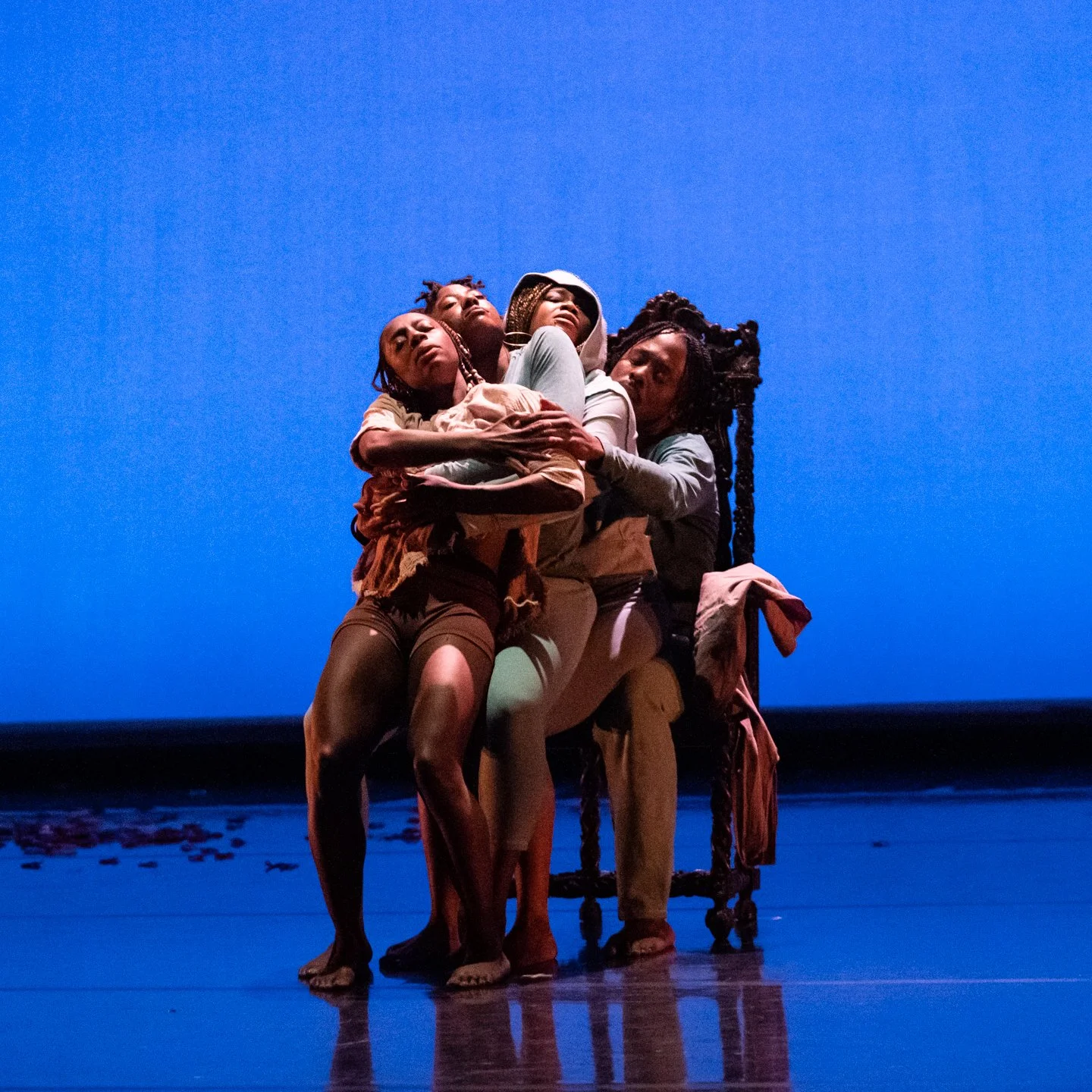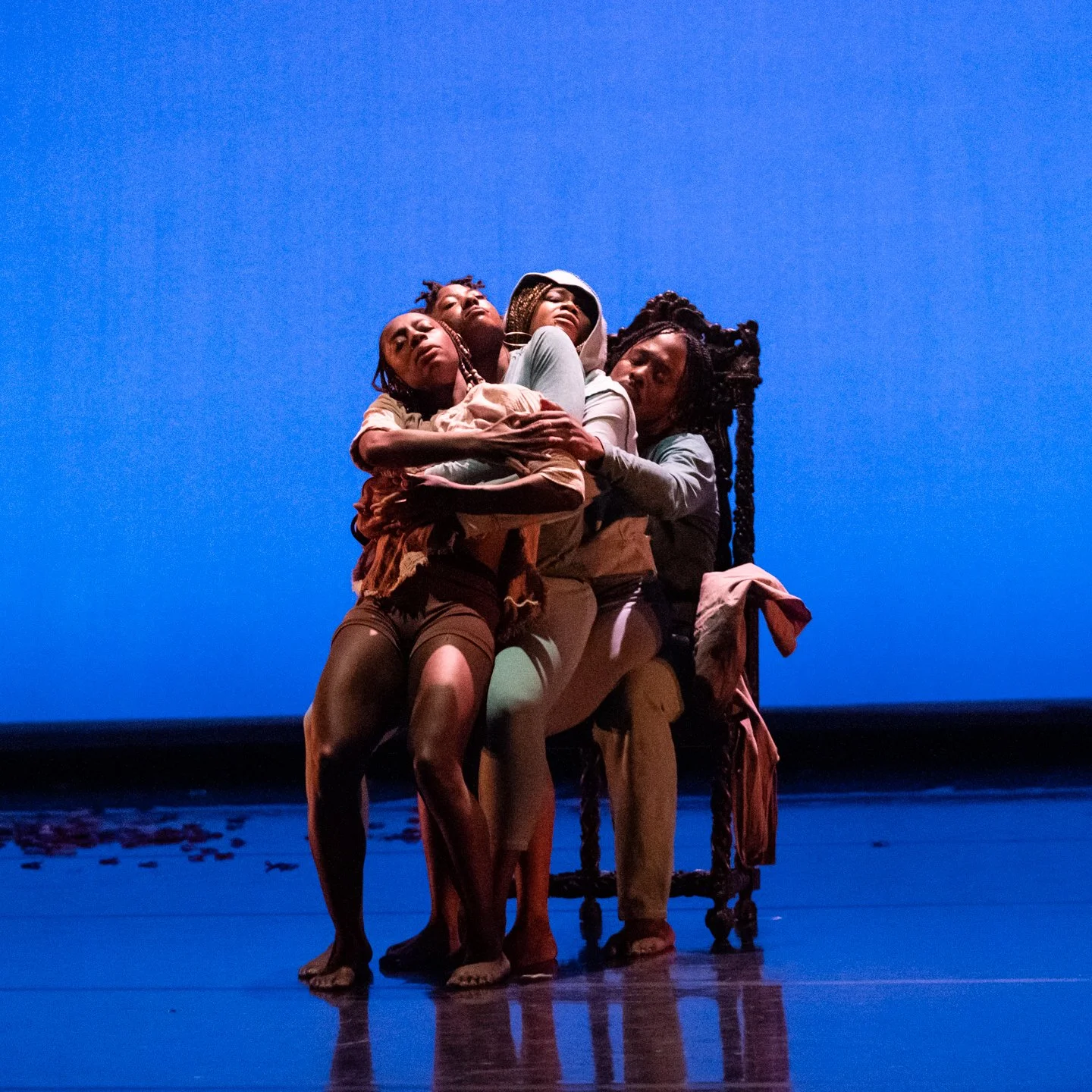By Nicole Nfonoyim-Hara

We brought forth a new world.
Manifested as a large luminous egg cradled in the hands of dancer and choreographer, Alanna Morris, we birthed new and ancestral selves back into a world re-made in our own divine image.
The egg—noble, regal, cosmic, and sacred—lifted toward the heavens. Damballah, creator of all life has presided over this final co-creation. The twin serpents of his signature vèvè shimmer like constellations on a sequined-studded drapo Vodou held by dancer, singer, and choreographer Djenane Saint Juste. As the curtain closes, the Yanvalou rhythm played by the drummers of Afoutayi Haitian Dance, Music and Arts Company mirrors the immersive sound of a pulsing heartbeat that first opened the performance. I am awestruck and breathless in the audience, watching Morris glide across the stage. The ruffled hem of her white initiate’s skirt mercurial—at once, primordial waters and starshine. She disappears into the stage wings expectant with the promise of liberation.
Liberation as both birthright and practice is woven through each movement and each of the six acts of Black Light a re:Search performance. Frankly, I am still searching for an alternative word to “performance.” What I experienced was ritual, ceremony, and an invitation to co-creation and transformation. And, as I have felt before with Morris’ work, the usual ways in which we are expected to take in dance and performance with a clearly delineated stage ahead and a seated, mute audience feels wholly inadequate. The performance’s centering of Afro-Atlantic cosmologies, music, and dance traditions implodes any notion of a separate voyeuristic spectator. Morris calls us in and what we do with that call is up to us. I am comforted by the familiar ululations and vocalizations I hear backstage from her fellow dancers and some, myself included, in the audience. I am among kin. Dance is at once intimate and communal medicine. Black folk know this, but that knowing is present in every one of us. It is joyful, ancient, and divine. And part of what Black Light is asking us to reach for is precisely this part of ourselves.
Black Light begins by calling in the ancestral and the divine. Orisha appear one by one granting their blessings, gifts, and wise warnings for the journey ahead: the mesmerizing laughter of Oshun, the power and grace of Yemaya in a flash of blue, the red-hot fierceness of Shango, and of course, Oya. Oya, who appears and reincarnates throughout the performance as Morris’ met tet, the guardian of her head. While Morris is not an Ifá initiate, the homage she pays to Oya is central to Black Light. Oya is change as God is change.¹ And her invocation at the very start of the performance is a signal to destroy that which no longer serves, to embrace destruction and sure death to make way for necessary new growth, creation, and ultimately freedom.
The word “free” has roots in the words to love and beloved. Reflecting on the archaic etymology of “free” reminds me of the role of love in liberation and changemaking in Black thought and movement building—a concept that ancestor bell hooks worked to center in her cogent gathering of not just the political and social, but the spiritual and emotional realms of struggle and revolution. hooks spoke about the process of love as the practice of freedom, writing: “The moment we choose to love we begin to move towards freedom, to act in ways that liberate ourselves and others. That action is the testimony of love as the practice of freedom.”²
In “Self Pleasure/Self Love,” Morris is flanked by full length mirrors in the back corner of the stage. Erykah Badu’s unmistakable reedy vibrato fills the air as Morris dances for only herself. She begins to sing as Badu’s Orange Moon phases out. Remixing the gospel song You Are The Living Word, Morris unequivocally claims her divinity… I am my living word. In this act, we are reminded that any process of love starts at home—with the self. And that self, embodied as a Black woman has come to love despite every weapon formed against her and every oppressive power that has sought to destroy her. In “The Uses of the Erotic: The Erotic as Power,” queer warrior poet and ancestor Audre Lorde writes “There are many kinds of power, used and unused, acknowledged or otherwise. The erotic is a resource within each of us that lies in a deeply female and spiritual plane, firmly rooted in the power of our unexpressed or unrecognized feeling. In order to perpetuate itself, every oppression must corrupt or distort those various sources of power within the culture of the oppressed that can provide energy for that change.”³ And here again we see the language of change.
“And lest we forget that Oya is a hurricane, her power to create and destroy is rooted in the natural world—a world that we are killing. Racial justice, climate justice, economic justice, queer justice. This is all connected, we are all connected.”
Black Light feels like an antidote to the white supremacist legacies that greet us in the mirror, in our doorways and along the harrowing generational paths we’ve survived. Anti-Blackness is a poison. Anti-Blackness is Anti-Love. And as James Baldwin often asserted, it infects us all. I sit in the audience at the Cowles Center a few short days after the shooting death of Amir Locke in Minneapolis. I sit masked with my fellow audience members, all of us still reeling from pandemic life. And lest we forget that Oya is a hurricane, her power to create and destroy is rooted in the natural world—a world that we are killing. Racial justice, climate justice, economic justice, queer justice. This is all connected, we are all connected. And if we heed the call of Black Light, we might begin to uncover for ourselves where the medicine might be found and how to administer it to our own broken bodies and weary spirits and then, to each other. For anti-Blackness is as much about the attempted destruction of Black people, as it is about the systemic destruction of the “Black light” within us all. Black light is not just color, race, or kin. It is the divine, the expansive, the fluid, the joyful, the Spirit-centered, the erotic, the soft, the sweet, the supple, the vulnerable, the survivor, the warrior, the dreamer, the radical, the creatrix, the lover.
As a political term, Black has always encompassed more than racial constructs and shades of melanin. The term has always been less about a people bound by oppression, but rather a people united in power and hope. One of the many gifts of Black Light is its deep reverence and centering of Haiti/Ayiti. Haiti is the first Black Republic and is one of the earliest experiments in Black futures and Black radical imagination. To honor Haiti is not to romanticize it or to ignore the realities of Haiti and her people today, but to name her often undervalued place in Black history and in human history. In her research, Morris kept encountering the Haitian Revolution and the performance features the dancers, choreographers, singers, and musicians of Afoutayi Haitian Dance, Music, and Arts. Djenane Saint Juste, Florencia “Fofo” Pierre, Jacinthe Jean, Wilson Charles, and Beavois Anilus “Zangi” are all culture bearers and keepers as well as respected spiritual leaders in the Vodou tradition in their own right. Spirit as central to any transformation or revolution is deeply embedded in the history of Haiti and its struggle for liberation. The “Yanvalou & Mayi” act of Black Light feels like a celebration and a rebirth. It honors both Haitian Vodou as well as the Mayi warrior dance of the Tainos, the indigenous people of Haiti.

Throughout the performance I was reminded not only of the serpentine structure and movement of Damballah in the Vodou tradition, but also of the Sankofa, the Ghanaian adrinkra symbol of a bird walking forward, but with its head craned back toward the path behind it. In the Umfundalai African dance technique, sankofa is embodied through “S” shaped movements of the body in space. The structure of Black Light feels like that—less a progression from beginning to end or even a linear process of gestation and incubation to birth. But rather something more winding, cyclical, ever emerging: an ouroboros always in a state of destruction and rebirth and the ancestral wisdom of sankofa embodying past, present, and future all at once. Morris’ own process and the title of the performance captures this perfectly… “a re:search”. What are we looking for and what do we find? Is the searching, the excavating ever truly complete? Completion seems a foreign concept in Afro-Atlantic traditions where cycles and the alchemy of transformation and metamorphosis are never deceived into the hubris of linear progression. Rather, they honor totality over binaries, circles and infinite dimensions over a fixed line between two discreet points.
“Black Light reminds us that we all have access to that light within us and that bringing it forth into the world is critical, urgent medicine for ourselves and ultimately, the collective.”
In each act, Morris seems to embark on her own heroine’s journey. In “Latent Psyche” and “Mooji/Self-Realization,” Morris asks us to discover our true shadow selves along this journey. Touching our psyche is painful and disorienting—paralyzing even. Nestled in the performance between “Self Pleasure/Self Love” and “Sokah,” this trip to Morris’ psychic underworld, is vital for any future healing to occur. In “Latent Psyche” Morris and fellow dancers Gabrielle Abram, Andrea Potter, and Demetrius “ImagineJoy” McClendon circle a throne. They urge us to consider that which we have cast off, maligned, and shamed inside us. Might these shadows, too, be sources of light? We must pass through our own underworlds fully, meet the ghosts and riddle with the sacred trickster at each crossroad in order to access the medicine. Medicine, which we realize has really been in us all along. Jamaican spiritual teacher Mooji’s sage twinkling voice is reminiscent of that sacred trickster as Morris moves to the cadence of his wise words deconstructing her self-inquiry: If freedom and liberation are already what I am…. freedom and liberation are already what I am…
I am finishing this reflection three weeks since I first sat in the audience answering the call to be a doula of Black Light. The words seem to have gone through their own cycles excavating meaning, birthing new insights. Black Light sinking into my being. I have been tending to my own creation, my own labor pains toward liberation. Inspired by the “Sokah” section of Black Light, I’ve found myself taking solitary moments in my kitchen whining to “Mind My Business” by Patrice Roberts as snow falls outside my window. The alienation and isolation I often feel as a Black woman in the southeast Minnesota town I call home, falling away as my body remembers ancestors and kin near and far and my own divine self, healing, creating, moving toward joy and liberation as a birthright.
Black Light reminds us that we all have access to that light within us and that bringing it forth into the world is critical, urgent medicine for ourselves and ultimately, the collective. Black Light takes us to beginnings and origins, to cunas and ground zeros of Black self/love, radical imagination, futures and acts of creation. For what is imagination, but a mad flame blazing into the impossible, what is creation if not conjuring the wildest dreams of the ancestors, what is freedom and liberation if not radical love. Love, love, love… Love and Black Light.
¹ Butler, Octavia E. 1995. Parable of the Sower, New York: Warner Books
² hooks, bell. 1994. Outlaw Culture, New York: Routledge.
³ Lorde, Audre. 1978. Uses of the erotic : the erotic as power. California: Distributed by the Crossing Press.

Nicole “Cole” Nfonoyim-Hara (she/her) is a writer committed to liberation and community building through stories. Her work has taken her around the country and the world. She serves as host and associate producer of R-Town, a civic and cultural affairs shows about Rochester, MN on PBS station, KSMQ-TV. Her fiction writing has been recognized by the Minnesota State Arts Board, the Loft Literary Center, the Givens Foundation for African American Literature, and VONA/Voices of Our Nation. Her arts writing has been featured on MN Artists and exhibition catalogues for the MCAD-Jerome Foundation Fellowships for Early Career Artists. A former Fulbright scholar in cultural and applied anthropology, she holds a BA from Swarthmore College and earned her MS degree from Oxford University. She is mama to Zoraida and Nova Sojourner and lives with her husband and family in Rochester, MN.

